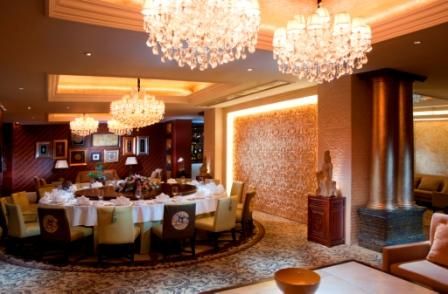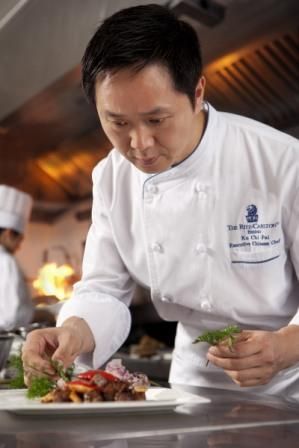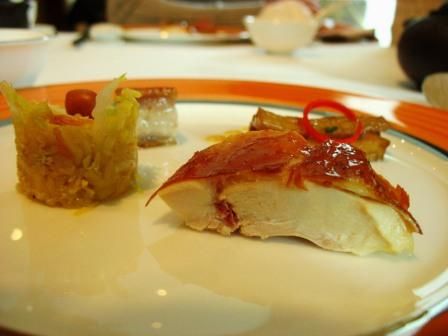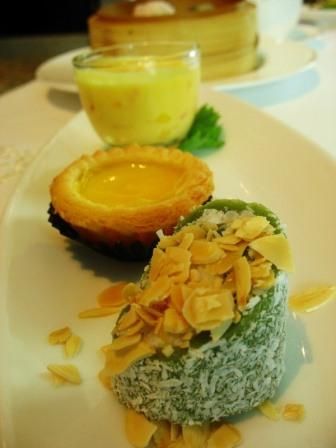玉餐厅 品春“鲜”为最
http://www.sina.com.cn 2011年04月02日 16:31 Best Food in China美食中国网
从古至今,玉在中国就被视为“帝王之石”。如同钻石和黄金在西方所赋予的意义一般,玉在中国的珍稀与高贵也经常被制成最精美的艺术品和工艺品。装饰于餐厅中那枚光彩润泽,莹透细密的羊脂凝玉,可谓是玉餐厅菜肴餐品的完美代表,也象征了该餐厅在北京粤菜馆中领军地位。
 餐厅内部的奢华装潢
餐厅内部的奢华装潢步入餐厅的瞬间,如同迈入了世纪王朝统治的帝王皇宫:脚下百合般洁白的毛绒地毯以及暖色调精湛工艺的红木家具,璀璨闪耀的烛台镶嵌在精心雕刻的底座上,桌与桌之间宽大的空间提供了私密静幽的用餐氛围,让您拥有帝王般的享受。最引人瞩目的是一面中药柜装饰墙,让人仿佛置身于中医药馆一般,各色药材会聚其中。除了用餐大堂,餐厅为了宴会和活动另设有七间富丽堂皇的包间,用心收集的佛像点缀在蜿蜒木刻的走廊之中。
 餐厅的主厨古师傅
餐厅的主厨古师傅在中国传统文化中,四季占有了重要的意义,餐厅的主厨古师傅近期就推出了新春菜单。每一道菜肴都与“春”的宏观主题相呼应:重生,活力,生机,轻盈,和“轻靛”,意为清爽纯净。古师傅精通亚洲各色烹饪厨艺,并将自己的热忱与创意注入到新的菜色当中。他坚持选用质量顶级,季节限定和当地特产的食材入菜。融合了日式菜肴的精髓与雅致,古师傅将传统与创新结合到顶峰,在传统菜肴中融入了现代的演绎。他的精湛厨艺与工作热情让每一位食客都能真正感受到世界级的美食体验。
 前菜4种
前菜4种首先,迎接我们的是浓郁沉香的普洱茶,配有用心挑选的精致开胃前菜,蘑菇白菜丝佐炸鸡肋,工整地摆放在盘子的四方,再用奶油酱汁沿着三直线做放射点状装饰。蘑菇的质地松软滑嫩,清淡可口的香味之中点点微辣更添风韵。成束的白菜丝,口感不干涩,质地细腻亦伴有点点麻油甜香。鸡肉的口感更是令人称绝,脂香奶香浓郁的肉质以及清爽酥脆的油炸外皮,堪称绝配。
 盛在玉制碗中的汤品
盛在玉制碗中的汤品接下来,我们品尝了一道盛在玉制碗中的汤品。清爽的口感和清澈的外观,单纯质朴的配料延续了之前轻靛的主题。汤的主要原料是花胶,一种罕见的鱼鳔制品,取材于特定的鱼种,而每公斤上万元的不菲价格更令整道汤品出类拔萃,与众不同。花胶赋予了汤品一种独特的味道,甜中带咸,味道近似于煮熟的胡萝卜,而花胶本身口感十分柔软滑嫩,入口似肥肉一般,又如煮熟的蔬菜,同时还兼具女性养颜美容盛品的美誉。
澳洲牛肉和芦笋的结合可谓是古师傅融合各色口味与风格的标志性菜品,是古师傅精湛厨艺的重要里程碑。广式烹饪或粤菜以清淡和原味而闻名,而北京菜的味道相对厚重。切工精细的牛肉块工整的摆放在芦笋之上,肉质软嫩,酱色浓重,入口满满浓郁鲜香。牛肉的浓郁香味与芦笋的清爽酥脆相互辉映,达到完美的平衡。
另一道值得称赞的是桂林米粉,一种贵州省最富盛名的米制粉条。米粉的口感软而不烂,汤汁洁白浓郁丰厚如牛奶一般,再有些许麻油点香。当然,也配上了精致美味的蒸饺。虽然并非传统的广式菜肴,但我对古师傅将地方菜色改良,以适应广东口味的创新深表赞同。
上述提到的浓汤在中国南方被称作高汤。 据说,这种汤从古至今一直如法炮制,从未改变,炖高汤的炉火也被整个家族世世代代延续了下来,日复一日,从未熄灭。古师傅花费六小时熬制的汤头集尽了浓郁丰厚的美味,如此美味如今也愈来愈珍稀难寻,恐怕只有在玉餐厅这样的优质餐厅才能品尝到这久负盛名的菜品了。
最后,贴心的服务员为我们送上了一竹篮蒸饺,这是广式菜肴中最著名的点心。蒸饺的外皮轻柔有粘性,状如螺旋清澈透明,如同光滑的玻璃浴屏。内馅却色重而味浓,更偏向北方人的喜好。亵渎经典是一种罪过,然而改良和创新确是天赋的展现。
 甜品三种
甜品三种此次用餐的完美结尾是一盘美味诱人的精致甜点,绿茶卷覆上杏仁片,内馅清淡,幽幽薄荷香气;一口大小的蛋挞,派皮酥脆诱人,内馅松软香甜;柔滑软嫩的牛奶布丁配新鲜水果丁。
用餐中,来自香港和广州的商务人士相谈甚欢,而尽职的服务员也贴心的续茶,热乎乎的普洱茶令我们谈笑间亦口齿留香。皇家般的尊贵享受就在玉餐厅,恭候您的光临。
服务:非常好
菜品:非常好
环境:非常好
人均:400 – 500元
地点: 北京朝阳区建国路83A,北京华贸丽思卡尔顿酒店内。
电话:(86 10)5908 8958
The lustrous, fine, “mutton-fat”varnish of ornamental jade is perfectly representative of the cuisine servedhere at Yu, one of the flagship Cantonese fusion restaurants in Beijing。
Since ancient times, jade has beenconsidered the “imperial stone” of China. Carrying the significancethat diamonds and gold enjoy in the West, “Yu,” often translated as jade or“precious stone,” has long been used for the finest of artistic objects andartifacts. The lustrous, fine, “mutton-fat” varnish of ornamental jade isperfectly representative of the cuisine served here at Yu, one of the flagshipCantonese fusion restaurants in Beijing。
Entering the restaurant is almostlike setting foot into an emperor’s palace of epochal dynasticism: plush,lily-white carpet beneath your feet alongside master-crafted furniture of warm,red mahogany; shimmering chandeliers nestled in carved planchements proudlybeam, while ample space between tables provide an intimate, ambrosial diningexperience fit for royalty. Notable is the decorative medicinal cabinet walls,designed like a Chinese medicine man's dutifully organized smorgasbord ofalchemical reagents. Beyond the dining hall are seven paradisiacal chambers forrecreation and banquets, complete with a cultivated collection of Buddhastatutes stationed throughout the winding, wood-cut halls。
The four seasons have a profoundimportance in Chinese culture and Chef Ku has recently introduced Yu's newSpring menu. Each dish ushers in common themes associated with spring: rebirth,variety, freshness and lightness, or qingdian, meaning “light and clear。” ChefKu has honed his skill in kitchens across Asiaand brings his passion and creativity to Yu's new menu. He insists on onlyusing top-quality, seasonal ingredients that are locally produced. Equallyinfluenced by the grace and focus of Japanese styles, his culinary aesthetic isthe culmination of tradition and innovation, often interpreting classic disheswith a contemporary flourish. The result of his expertise and enthusiasm is atruly world-class gastronomic experience。
We first were served aromatic pu'ertea, along with a dainty appetizer selection of slender mushroom tubes,cabbage, flank and fried chicken, all neatly seated on the plate along the fourcardinal directions, embellished by three linear dots of cream. The mushroom'stexture was spongy and soft, with a light and pleasant flavor hiding a hint ofspice. The bulb of sliced cabbage, not too dry, had a fine texture and produceda sweet, sesame flavor. The chicken was truly divine: balmy, creamy meatembraced by the light crunch of the quick-fried skin。
Next, we tried a soup, presented ina jade bowl. As a continuation of the theme, the soup was an unheavy and clearbroth, with its simple ingredients plainly visible. The main component washuajiao, a kind of rare fish belly found only in certain species. The fact thatit is priced at over 10,000 yuan per kilogram made it especially exotic! Thehuajiao gave the broth a very distinct flavor: sweet, tangy and salty, with aflavor similar to boiled carrots, while the huajiao itself was very soft with anice taste, like eating fatty meat or boiled vegetables. It is said thisingredient is good for the skin of a woman's face。
The Australian beef and asparaguswas indicative of Chef Ku's trademark blending of different flavors and styles.Although Cantonese cooking, or Yue cai, is known for its lightness of textureand flavor, Beijing-style cooking is usually heavier. The well-cut beef cubeswere arranged lovingly on the asparagus bed and responded with a gentle givewhen bitten, filling the mouth with a soy-like and slightly chocolatey juice.The beef was heavy on flavor, with the crisp and crunchy asparagus serving as abalanced counterpoint。
Another notable dish was the guilin mifen, a kind of rice noodle popular in Guizhou Province. The noodles, soft yetunyielding, were served in a white, milky broth mixed with browned sesameseeds. Also added were taut, steamed and scrumptious dumplings. Although nottraditional Cantonese food, the chef made a point to mention how he had alteredit enough to be deemed appropriate for the Cantonese palate, and I would haveto agree。
The aforementioned broth wasinspired by what is known as gao tang in southern China. It is said that, in yearspast, this soup would be cooked continuously for decades, entire generations offamilies keeping the flame alive, day after day. Chef Ku cooks the soup for sixhours, which was still more than enough for the deep and rich flavors tomature. As gao tang has, for obvious reasons, become difficult to findthroughout modern Chinawhere it was once common, one must now go to fine establishments like Yu tohave a try of this esteemed dish。
Finally, our diligent server broughtus a steaming bamboo basket of dim sum dumplings, a staple of Cantonese food.The dumpling dough was light and sticky, some of them translucent andspiraling, like the glass of a glossy shower screen. The fillings were dark andheavy, again, to be better suited to a Northerner's preference. To defile a classicis a crime, but to renew and invent is a credit to one's faculty。
To end the procession was ourenticing dessert plate: A green tea roll covered in almond slices, filled witha light, minty paste; a bite-sized pie crust encasing a fluffy, sugary omelette;a soothing, thin milk pudding sprinkled with diced, lively fruit。
During the meal, Hong Kong and Guangzhou businessmenchatted away, while our ever-attentive server made sure our cups wereconsistently filled with warm pu'er tea to wash down each succulent bite. AtYu, a re-imagining of imperial luxury awaits you。
-- by Jonathan Alpart
Service quality: excellent
Food quality: very good
Environment: excellent
Price per head (RMB): 400-500
(作者:JonathanAlpart 翻译:李亦然)
